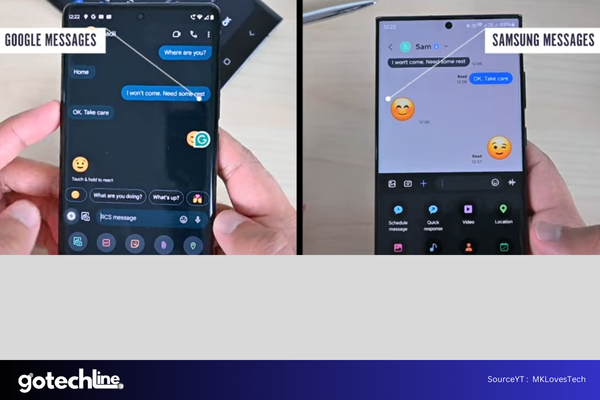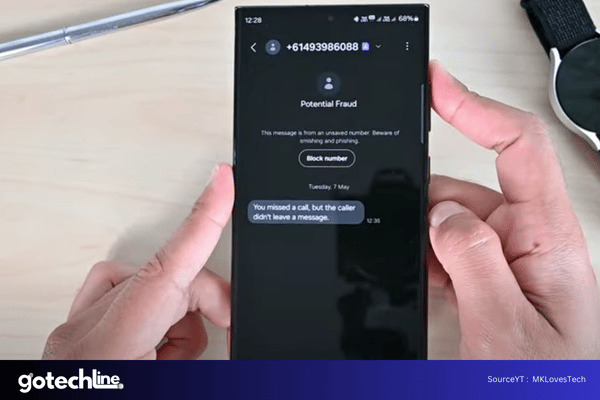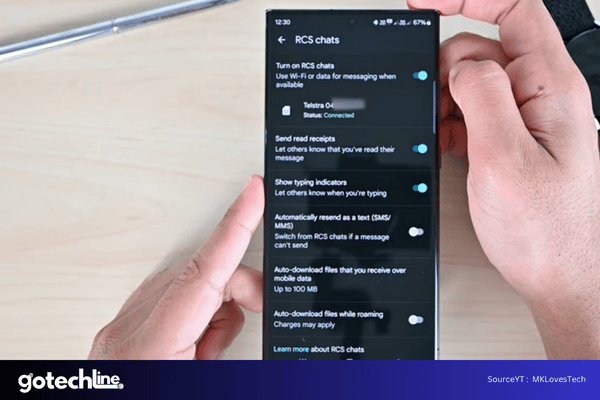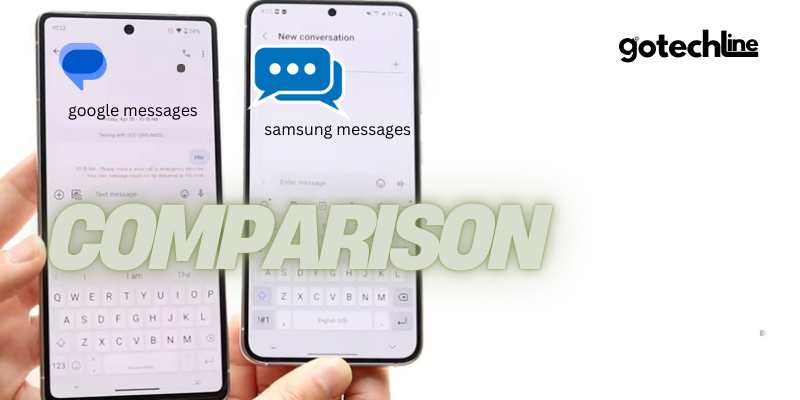In the modern communication world, messaging apps have become the primary tool for conveying information between smartphone users. Android, with its diverse devices and ecosystem, offers various messaging apps, two of the most popular being Samsung Messages and Google Messages.
Although both serve as apps for sending text and multimedia messages, they each have their own unique features, which often leaves users confused about which is the best choice for their needs.
To help you understand the differences and advantages of each app, we will conduct an in-depth comparison, reviewing various features and user experiences (UX), as well as how each app adapts to evolving communication trends.

This article will thoroughly examine different aspects of both apps, such as user interface, messaging features, message organization, customization options, and RCS integration, to help you determine which app best suits your needs.
User Interface: Design and Navigation Enhancing Chat Experience
The User Interface (UI) is the first thing you see when opening a messaging app. Both Samsung Messages and Google Messages offer a design intended to provide comfort, but each has a different approach in terms of visuals and functionality.

Google Messages: Colorful and Dynamic Layout
Google Messages offers a brighter, more colorful UI. Each contact is displayed with a colored icon that makes it easier to identify conversations.
Overall, the app has a more lively design with prominent use of colors, providing a modern and enjoyable look.
On the main screen, you’ll find messages displayed in a list format, with the most recent messages appearing at the top.
At the top of the screen, Google Messages also provides message categories to make navigation easier, as well as a button to start a new chat in the bottom-right corner.
This clean and intuitive layout ensures a smooth user experience, allowing you to quickly access important messages.
Samsung Messages: Minimalist Design with Focus on Readability
On the other hand, Samsung Messages emphasizes a minimalist design with a clean white background and a focus on simplicity.
While it doesn’t have the bright colors of Google Messages, Samsung Messages offers a very user-friendly interface. Messages are displayed in a list format as well, with the most recent message at the top.
One standout feature of Samsung Messages is the separate Contacts tab at the bottom of the screen, making it easy for users to quickly search and send messages to specific contacts.
This is a significant advantage if you frequently interact with multiple people and want to switch between contacts seamlessly.

User Interface Comparison:
- Google Messages: More colorful and dynamic, with contact icons in vibrant colors.
- Samsung Messages: Focuses on simplicity with a minimalist design and white background.
Message Organization Features: More Structured Management
Both Google Messages and Samsung Messages have their own ways of organizing incoming messages, and this is closely tied to how each app handles message categorization and archiving.
Google Messages: Automatic Message Categorization
One of the interesting features of Google Messages is its ability to automatically categorize messages.
There are four main categories available to help you sort messages automatically: Personal, Transactions, OTP, and Offers. This feature allows the app to sort messages based on their type, making it easier to access relevant messages without confusion.
However, the downside is that you cannot create new categories manually. All messages are automatically categorized based on their type, and there is no flexibility to add custom categories.
Samsung Messages: Customizable Manual Categories
In contrast, Samsung Messages gives you more freedom in terms of message organization. Users can create their own categories and add conversations to those specific categories.
For instance, you can create folders for family messages, work conversations, or shopping receipts, according to your needs.
The major advantage here is the flexibility, though it requires a bit more effort on the user’s part to set everything up.
Archiving and Recovering Messages
Message archiving is another essential feature to consider when selecting a messaging app. Google Messages allows you to archive conversations easily.
Archived messages are moved to an Archive folder and won’t appear in the main view of the app. You can access them at any time when needed.
On the other hand, Samsung Messages lacks a dedicated archiving feature, meaning you must find other ways to hide conversations if you no longer want to see them.
The manual categories can serve as a workaround, although it’s not as simple as the archiving feature in Google Messages.
Pinning Messages: Easy Access to Important Chats
If you frequently communicate with someone or have important conversations, the Pinning Messages feature can be very useful.
Both Google Messages and Samsung Messages allow you to pin conversations at the top of your list. However, the key difference lies in the number of conversations that can be pinned.
Samsung Messages allows up to 20 pinned conversations, while Google Messages restricts it to only 5 conversations.
If you interact with many people and want to prioritize conversations, Samsung Messages may be more beneficial in this regard.
Messaging Features: Complete Functionality for Busy Users
Now let’s take a deeper dive into the messaging features provided by both apps. Both Google Messages and Samsung Messages offer a variety of capabilities that can enhance your messaging experience, from scheduled messages to automatic replies and spam detection.
Message Scheduling: Send Messages at the Right Time
One highly useful feature for busy users is the ability to schedule messages. Both Google Messages and Samsung Messages support message scheduling, allowing you to write a message and have it sent at a specified time in the future.
To use this feature, simply tap the + icon next to the text field and select the Schedule Message option.
You can also press and hold the send button to schedule a message in Google Messages. This feature is perfect for ensuring that messages are sent at a specific time without having to wait to send them manually.
Quick Replies and Smart Replies: Save Time and Effort
For those who want to save time typing, Samsung Messages offers Quick Replies.
This feature lets you select from a list of preset responses like “Sorry, I’m busy” or “Please contact me later”. You can also add custom replies from the settings.
Meanwhile, Google Messages provides a slightly more advanced feature called Smart Replies.
Based on the received message, the app automatically suggests appropriate responses, even offering emoji or GIF suggestions to enhance the conversation. This feature uses Google’s AI capabilities to suggest more natural and context-aware replies.
Message Search: Find What You Need
Message search is an important feature when you have a lot of conversations to manage. Google Messages offers a comprehensive search bar at the top of the app, allowing you to search for messages based on specific categories, such as images, videos, or links.
This makes it easier to find messages containing specific types of media.
Samsung Messages also offers a similar search function, but with the added option to search within individual chat threads. If you’re looking for a specific message within a conversation, you can open the chat, tap the three-dot icon, and select Search Messages.
This gives you an additional way to browse through old messages.
Spam Detection: Enhanced Protection for Users

Google Messages has more advanced spam detection capabilities compared to Samsung Messages.
The app can automatically detect spam messages and give you a warning before you open them. Additionally, spam messages are automatically moved to a Spam folder to prevent any disruptions.
In contrast, Samsung Messages does not have automatic spam detection. However, you can still manage spam messages through the app’s settings.
RCS Messaging: Enhancing the Communication Experience

One of the newest features in messaging apps is Rich Communication Services (RCS), which replaces SMS and MMS with the ability to send richer messages over the internet.
Both Samsung Messages and Google Messages support RCS, enabling the sending of high-quality text, images, videos, location data, and other files.
However, there is a difference in terms of RCS accessibility. Google Messages supports RCS globally across many regions, while Samsung Messages is limited to certain carriers.
Additionally, while RCS works well between Google Messages users, cross-communication between Samsung Messages and Google Messages is not always RCS-compatible.
App Customization: Personalizing Your Message View
Users often appreciate the ability to customize their messaging apps to suit their personal style. Samsung Messages excels in this regard, offering more options for customization.
You can change the phone theme to influence the look of Samsung Messages, and even set custom backgrounds for individual chats.
In contrast, Google Messages is more limited in terms of customization. While the app supports dark mode, which provides a more comfortable viewing experience at night, users cannot change themes or chat backgrounds like they can in Samsung Messages.
Desktop Continuity: Access Messages on Your PC
Google Messages offers a web-based feature that allows you to send and receive messages directly from your PC.
Simply open Messages for Web, scan the QR code from the app on your phone, and you can start accessing messages directly from your computer.
On the other hand, Samsung Messages doesn’t offer this feature. However, if you’re a Samsung device user, you can utilize Link to Windows, which allows you to connect your Samsung device to a Windows computer and access messages and perform various other functions.
Conclusion: Choosing the Right App for Your Needs
Ultimately, the choice between Samsung Messages and Google Messages depends on personal preferences and how you want your messaging app to function.
If you want a more stable RCS experience, better AI support, and smart replies, Google Messages might be a better fit for you.
However, if you prefer customization with more control over messages and conversation settings, Samsung Messages would be a more suitable choice.


